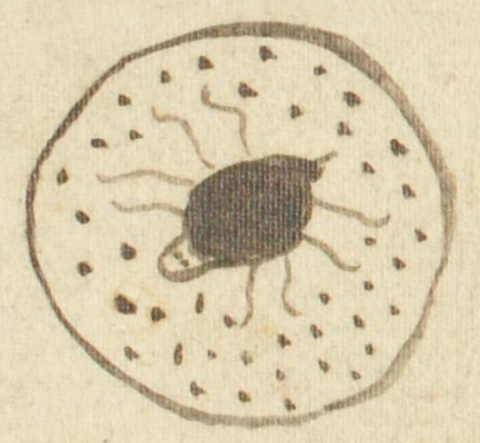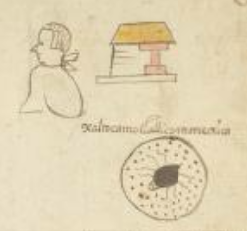Xaltocan (Azca14)
This black-line drawing of the compound place name Xaltocan (perhaps “Where [There Are] Sand Spiders”) shows a circle full of dots, surely sand (xalli). In the middle is a black-bodied, eight-legged spider (tocatl) with a small head. All of this is presented in a bird’s eye view.
Stephanie Wood
Xaltocan is an altepetl (socio-political unit) on an island in what was Xaltocan lake. The gloss here credits the Mexica with the founding of Xaltocan, but the Historia Tolteca Chichimeca states that the Otomies founded Xaltocan.
The Codex Mendoza shows two slightly different glyphs for Xaltocan, but in all cases the sand consists of dots. Whereas this glyph shows a bird’s eye view, the two Xaltocan glyphs in the Codex Mendoza show profile views of the spiders.
Stephanie Wood
xaltocamotlallicoynmexica
Xaltocan omotlalico in Mexica
Stephanie Wood
post-1550, possibly from the early seventeenth century.
Jeff Haskett-Wood
arañas, arena, paisajes, pueblos, topónimos, nombres de lugares

xal(li), sand, https://nahuatl.wired-humanities.org/content/xalli
toca(tl), a spider, https://nahuatl.wired-humanities.org/content/tocatl
-can (locative suffix), where, https://nahuatl.wired-humanities.org/content/can-2
Lugar de Arañas de Arena
Stephanie Wood
The Codex Azcatitlan is also known as the Histoire mexicaine, [Manuscrit] Mexicain 59–64. It is housed in the Bibliothèque Nationale de France, and hosted on line by the World Digital Library and the Library of Congress, which is “unaware of any copyright or other restrictions in the World Digital Library Collection.”
https://www.loc.gov/resource/gdcwdl.wdl_15280/?sp=14&st=image
The Library of Congress is “unaware of any copyright or other restrictions in the World Digital Library Collection.” But please cite Bibliothèque Nationale de France and this Visual Lexicon of Aztec Hieroglyphs.



